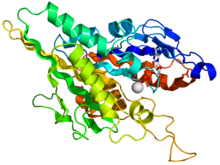Kinesin
| Kinesin motor domain | |||||||||
|---|---|---|---|---|---|---|---|---|---|

Crystallographic structure of the human kinesin motor domain depicted as a rainbow colored cartoon (N-terminus = blue, C-terminus = red) complexed with ADP (stick diagram, carbon = white, oxygen = red, nitrogen = blue, phosphorus = orange) and a magnesium ion (grey sphere).
|
|||||||||
| Identifiers | |||||||||
| Symbol | Kinesin motor domain | ||||||||
| Pfam | PF00225 | ||||||||
| InterPro | IPR001752 | ||||||||
| SMART | SM00129 | ||||||||
| PROSITE | PS50067 | ||||||||
| SCOP | 1bg2 | ||||||||
| SUPERFAMILY | 1bg2 | ||||||||
| CDD | cd00106 | ||||||||
|
|||||||||
| Available protein structures: | |
|---|---|
| Pfam | structures |
| PDB | RCSB PDB; PDBe; PDBj |
| PDBsum | structure summary |
A kinesin is a protein belonging to a class of motor proteins found in eukaryotic cells.
Kinesins move along microtubule (MT) filaments, and are powered by the hydrolysis of adenosine triphosphate (ATP) (thus kinesins are ATPases). The active movement of kinesins supports several cellular functions including mitosis, meiosis and transport of cellular cargo, such as in axonal transport. Most kinesins walk towards the positive end of a microtubule, which, in most cells, entails transporting cargo such as protein and membrane components from the centre of the cell towards the periphery. This form of transport is known as anterograde transport. In contrast, dyneins are motor proteins that move toward the microtubules' negative end.
Kinesins were discovered as MT-based anterograde intracellular transport motors. The founding member of this superfamily, kinesin-1, was isolated as a heterotetrameric fast axonal organelle transport motor consisting of 2 identical motor subunits (KHC) and 2 "light chains" (KLC) via microtubule affinity purification from neuronal cell extracts. Subsequently, a different, heterotrimeric plus-end-directed MT-based motor named kinesin-2, consisting of 2 distinct KHC-related motor subunits and an accessory "KAP" subunit, was purified from echinoderm egg/embryo extracts and is best known for its role in transporting protein complexes (IFT particles) along axonemes during cilium biogenesis. Molecular genetic and genomic approaches have led to the recognition that the kinesins form a diverse superfamily of motors that are responsible for multiple intracellular motility events in eukaryotic cells. For example, the genomes of mammals encode more than 40 kinesin proteins, organized into at least 14 families named kinesin-1 through kinesin-14.
Members of the kinesin superfamily vary in shape but the prototypical kinesin-1 is a heterotetramer whose motor subunits (heavy chains or KHCs) form a protein dimer (molecule pair) that binds two light chains (KLCs).
...
Wikipedia
